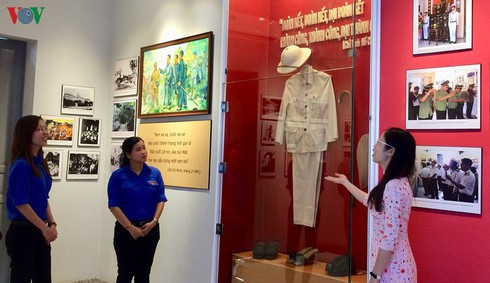The house was once the headquarters of the Lien Thanh Society – a group of intellectual merchants who sponsored contemporary patriotic movements. In September, 1910, with the help of the Lien Thanh Society, Ho Chi Minh, who was using the name Nguyen Van Ba at the time, left Phan Thiet for Sai Gon, now Ho Chi Minh City, where he lived in the Society’s headquarters complex until his departure.
During his nine-month stay, Nguyen Van Ba earned his living as a mechanic and newspaper hawker at a commercial port in District 5 while studying the patriotic movements of southern workers. To search for a way to liberate his country, in June, 1911, Nguyen Van Ba embarked from Nha Rong wharf on a ship named Latouche Treville as a cook’s helper.
Part of the old headquarters complex in Chau Van Liem street is now a Ho Chi Minh Memorial House. Guide Nguyen Thi Thu Thuy told VOV that this national historical relic often surprises first-time visitors.
“Visitors are interested in President Ho Chi Minh’s life before he traveled abroad: what he did, where he lived, and why he stayed here. People often visit this house on President Ho Chi Minh’s anniversaries,” Thuy said.
“President Ho Chi Minh’s relics can be found all over Vietnam. This house is small in size but great in historical significance,” Lan said. “He lived here with assistance from close aides while pondering how to liberate his country from subjugation.”
According to Huynh Hoang Anh Tuan, an official of District 5’s Cultural Center, which manages the house, it is most visited on the founding anniversary of the Communist Party of Vietnam (February 3), Reunification Day (April 30), and President Ho Chi Minh’s birthday (May 19). The house also serves as a venue for Party membership ceremonies.
Tuan told VOV “This relic has undergone several restorations. During the latest restoration in 2019, the facade was kept unchanged but the interior was upgraded. District 5’s Cultural Center hosts pilgrimage trips every year to this memorial house and to the Hospital for Tropical Diseases in Ho Chi Minh City, where Tran Phu, the first General Secretary of the Communist Party of Vietnam, died.”
Cultural officials in Ho Chi Minh City continue collecting documents and artefacts to be displayed in the house. Recently, a white khaki outfit, a pair of plastic sandals, and a telephone used by Ho Chi Minh were added to the collection. The house is open every day with guide service always available.




